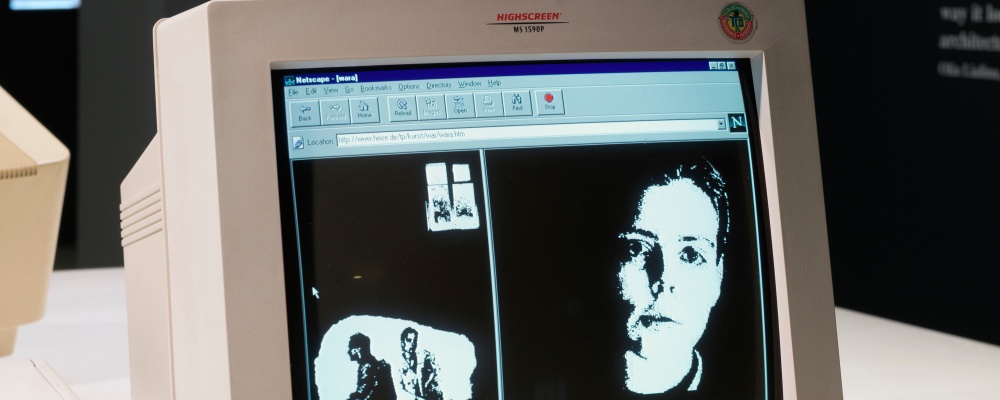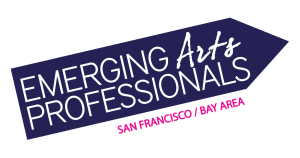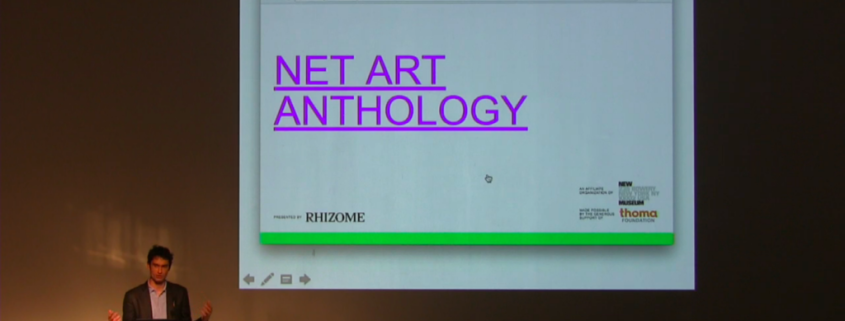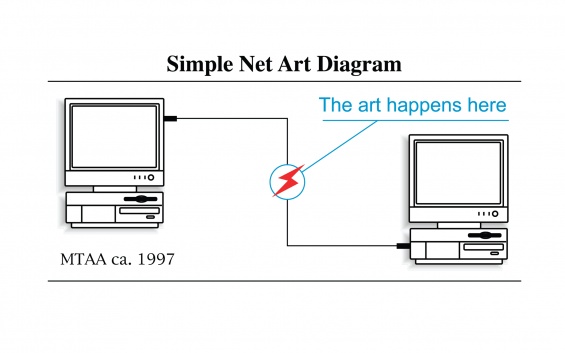Recap: Net Art Anthology Launch
On October 27, Rhizome launched a major new initiative, Net Art Anthology, with a presentation and panel discussion bringing together a group of artists who championed distinct and often conflicting approaches to net art practice in the mid to late 1990s. Our new New York correspondent, SF/NY-based artist Tim Roseborough, was there to take it all in. Here’s his rundown…
Net Art Anthology Launch
Thursday, October 27, 7 PM
at the New Museum, 235 Bowery in NYC
Luminaries like New Museum curator Lauren Cornell and Internet artist Rafael Rozendaal were in attendance for an event organized in conjunction with the launch of Rhizome’s Net Art Anthology, an online exhibition which, in the organization’s words, hopes to “retell the story of Net Art.” The Anthology commemorates the 20th anniversary of Rhizome as a proponent and archive of Internet-based art practices and is funded by the Carl & Marilynn Thoma Art Foundation.

Michael Connor introducing project
Michael Connor, Rhizome’s artistic director, introduced the Archive in which 100 Net-Based artworks will premiere, one a week, for two years. Mr. Connor’s introduction to the exhibition was accompanied by short talks by Aria Dean, assistant curator of Net Art and Dragan Espenschied, preservation director.
The panel consisted of artists who were involved in the early establishment of the field of Net Art in the 1990s: Olia Lialina (net artist and Geocities researcher/archivist), Martha Wilson (artist and founder of Franklin Furnace), Ricardo Dominguez (artist and founder of Electronic Disturbance Theater), and Mark Tribe (artist and founder of Rhizome).
Each artist discussed their early online work as artists, curators, and organizers. As well as some of the major issues faced and addressed by the organization and the world of Internet-based art, as a whole.
Mark Tribe remarked upon the fact that in the face of the Internet’s global reach, Rhizome’s New York-centricity was a problem. He noted that focusing on New York alone leads to, as he terms it, “navel gazing. In order to combat that myopia, Tribe described the site’s efforts to employ regional editors to chronicle the scenes in other cities. Martha Wilson noted that New York has always been a center for art and culture and that it was no surprise that Rhizome’s coverage and reach would reflect its status as such.
Ricardo Dominguez noted that Rhizome networks were broad, including cities like Vienna, Berlin, and Amsterdam, he noted the “teleportation” of the body that is facilitated by the broad reaching networks of the Internet.
The notion of the body and its mediation was a recurring theme at the panel. Martha Wilson discussed what she considered the myth of cyberspace as leaving the body behind. Regarding the ongoing conversation about the value of live performance art versus the importance of documentation of that performance, or the notion that “if it was not recorded, it didn’t happen.”

On Net Art’s relation to the avant-garde, Mark Tribe noted that like video art critiqued dominant forms like television, so Net Art can serve as a critique of the privatization of public space.
Olia Lialina noted that as a Russian artist, connecting with people abroad was an invaluable value offered to her as an Internet-based artist. She savored the fact that orders could be virtually crossed via the electronic superhighway.
Mark Tribe dismissed the notion that after After Modernism, art could explore no new avenues. The Internet opened new ways of making and thinking about art, according to the Rhizome founder.
The Rhizome founder also explained that the sense of excitement he felt when starting Rhizome in the mid-nineties is hard to recall. He noted that there was a sense of stepping across a threshold and into new frontier — much like the television show, “Star Trek,” he joked, eliciting laughter from the lively and engaged audience.
___________
Tim Roseborough, author of the artworldgeek.com blog.




Leave a Reply
Want to join the discussion?Feel free to contribute!